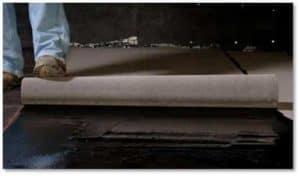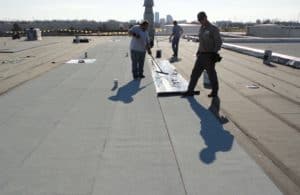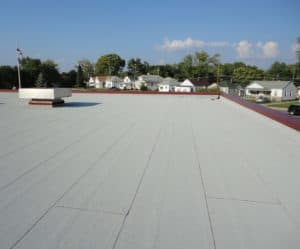Written by Sara Jonas and Tim Kersey, members of the Communications, Marketing and Education Committee for ARMA
SBS Modified Bitumen Roofing Systems are popular choices for low-slope commercial, industrial and institutional buildings when an asphalt system is desired. In addition to providing beauty, affordability and reliability, these systems are trusted to perform exceptionally well against extreme weather conditions. One beneficial aspect is that they can be applied using a variety of different methods, including cold adhesives, torch, self-adhered or hot asphalt, to meet any individual low slope roofing needs.
Today, cold adhesive applications are as common in the low slope roofing market as hot asphalt. Cold adhesives, along with flashing cements, plastic cements, sealants and primers, are all asphalt-based products and are an important component of modern asphalt-based roof membrane systems.
 Cold adhesives are generally composed of bitumen, solvent, fibers, fillers and stabilizers; some may also contain rubber polymers such as SBS. As the solvent evaporates from the adhesive, the remaining components bond to the modified bitumen surface of the membrane by a type of solvent weld.
Cold adhesives are generally composed of bitumen, solvent, fibers, fillers and stabilizers; some may also contain rubber polymers such as SBS. As the solvent evaporates from the adhesive, the remaining components bond to the modified bitumen surface of the membrane by a type of solvent weld.
Cold Adhesive Application Benefits
For situations in which solvent-based adhesives cannot be utilized, there is a relatively new class of cold adhesives with high solids content that provides options for ultra-low VOCs. Because of the low solvent content, there is virtually no odor to these adhesives, thus they may be installed over occupied buildings and require little to no special handling precautions. These environmentally friendly materials not only act as an adhesive, but upon curing they add an additional elastomeric, polymer-modified, water-resistant layer between the modified bitumen sheet materials and the substrate.
- Roof membranes may be applied with fewer restrictions.
- Occupied buildings such as schools, hospitals, and offices may be reroofed with the use of low odor and ultra-low VOC cold adhesives.
- All roof membrane components are in small enough packages that they may be transported by elevator.
- Buildings with limited rooftop access can be roofed with high performance, redundant SBS-modified membrane systems without the need for cranes or other heavy equipment
- Contractors can save costs.
- No open flames and no hot kettles can improve working conditions for the crews and potentially lower costs.
- Potential lower Insurance rates with no open flames or kettles on the job.
- Excellent membrane performance is achieved.
- Cold adhesive (solvent-welding) and flame or hot air (heat-welding) applications provide monolithic membrane performance.
- Based on test results utilizing ASTM D5849 Standard Test Method for Evaluating Resistance of Modified Bituminous Roofing Membrane to Cyclic Fatigue (Joint Displacement), cold adhesive modified bitumen membrane systems can pass both the unaged and aged test methods associated with this cyclic fatigue test method.
 Some Application Tips
Some Application Tips
- Comfort and safety
- If solvent-based adhesives are used, ensure that solvent vapors will not be drawn into the building.
- Most, if not all ultra-low VOC material may be used without this precaution.
- Avoid contact with sources of ignition.
- If solvent-based adhesives are used, ensure that solvent vapors will not be drawn into the building.
- Membranes for use with cold-applied adhesives.
- Always use sand-surfaced sheets; never use with film-backed sheets.
- Relax sheets prior to their installation if membrane does not lay flat.
- Jobsite Conditions (Temperatures).
- Ambient temperatures should be between 50°F and 100°F; however applications are acceptable in temperatures below 50°F if the following precautions are taken.
- Cut rolls in halves or thirds, and allow sheets to relax prior to installation.
- Ambient temperatures should be between 50°F and 100°F; however applications are acceptable in temperatures below 50°F if the following precautions are taken.
- Positive drainage is required.
- In any areas of ponding water, heat-welding the side and end laps is highly recommended.
- Refer to manufacturer for fastening requirements for roof slopes above 1/2:12.
- Cold Adhesive Application Rates.
- Field coverage rates are between 1.5 – 2.0 gal/100 square feet (0.6 – 0.8 L/m2) for the interply layers and will be higher for the first layer installed on porous substrates.
- Installation can be done with a V-notched squeegee, roller, brush or approved spray equipment. A 5/16 inch (8 mm) V-notched squeegee will deliver the proper interply rate Of 1.5-2.0 gal/100 square feet.
- Solvent-based adhesives are self-priming so applying an additional 1.0 gal/100 square feet (0.4 L/m2) over absorptive substrates is generally necessary.
- Set-up (i.e., evaporation time) varies based on drying conditions, such as temperature, humidity and wind, as well as the type and amount of solvent and coverage rates.
- During set-up time, roof traffic should be avoided in order to prevent adhesive displacement.
 For more information, please review manufacturers’ cold adhesive product data sheets, cold adhesive installation procedures and general requirements.
For more information, please review manufacturers’ cold adhesive product data sheets, cold adhesive installation procedures and general requirements.
If cold adhesive is not appropriate for a particular application, modified bitumen membranes may also be applied by torch (heat-welding), self-adhesive or hot asphalt.
For more information about low slope asphalt roofing systems, visit the ARMA website at www.asphaltroofing.org.
References
RCMA Tech Note – April 2012: Cold-applied Adhesives for Modified Bitumen Membrane Roofing.
http://roofcoatings.org/wp-content/uploads/2011/10/4932_RCMA_tech-note_4.pdf
NBEC 11th Canadian Conference on Building Science and Technology Proceedings – May 2007, Tim Kersey, Kirk Goodrum, Jeremy Turner: Performance Properties of Interply Adhesives Used with SBS-Modified Bitumen Membranes
http://www.nbec.net/documents/PERFORMANCEPROPERTIESOFINTERPLYADHESIVESUSEDWITHSBSMODIFIEDBITUMENMEMBRANES-TIMKERSEY.pdf
RCI Interface – August 2003, David A. Scheirer: Cold Adhesives Increase BUR Options.
http://www.rci-online.org/interface/2003-08-schierer.pdf
NRCA – September 2002, Tim Kersey, Ernesto Santos and Kirk Goodrum: Performance Properties of Interply Adhesive Used with SBS-Modified Bitumen Membranes.
https://www.nrca.net/rp/technical/search/librarydetails.aspx?IDNumber=133561
RCI Interface – November 2002, Paul M. Mitchell: History of Polymer Modified and Cold Process Roofing.
http://www.rci-online.org/interface/2002-11-mitchell.pdf
RCI Interface – February 2000, Terence J. O’Connor: Cold-Applied Systems Heating Up Bituminous Roofing Market.
http://www.rci-online.org/interface/2000-02-oconnor.pdf

